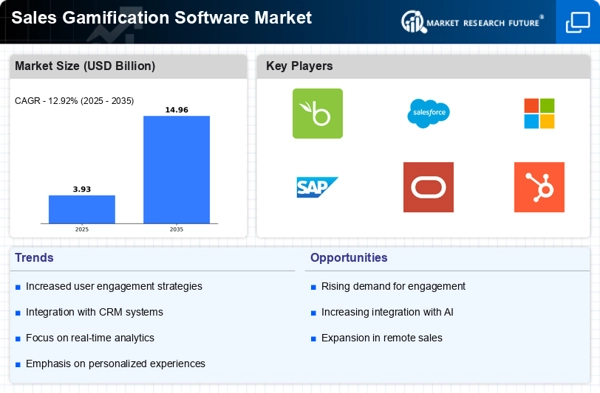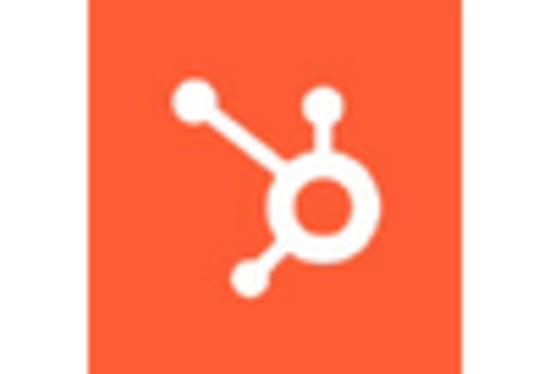Advancements in Technology
Technological advancements are significantly influencing the Sales Gamification Software Market. The integration of artificial intelligence and machine learning into gamification platforms is enhancing the user experience and providing valuable insights into sales performance. For instance, AI-driven analytics can identify top performers and tailor challenges to individual sales representatives, thereby optimizing training and development. This technological evolution is expected to drive market growth, as organizations increasingly seek sophisticated solutions that can adapt to their unique needs. Furthermore, the rise of cloud-based solutions allows for seamless updates and scalability, making gamification tools more accessible to businesses of all sizes. As technology continues to evolve, the Sales Gamification Software Market is likely to see a surge in innovative offerings that cater to the dynamic requirements of modern sales teams.
Rising Demand for Employee Engagement
The Sales Gamification Software Market is witnessing a notable increase in demand for tools that enhance employee engagement. Organizations are increasingly recognizing the importance of motivated sales teams in driving revenue growth. According to recent data, companies that implement gamification strategies report a 20% increase in employee engagement levels. This trend suggests that businesses are investing in gamification solutions to foster a competitive yet collaborative environment, ultimately leading to improved sales performance. As organizations strive to retain top talent, the integration of gamification into sales processes appears to be a strategic move to boost morale and productivity. The Sales Gamification Software Market is thus positioned to benefit from this growing focus on employee engagement, as more companies seek innovative ways to motivate their workforce.
Growing Adoption of Remote Work Solutions
The Sales Gamification Software Market is adapting to the growing trend of remote work solutions. As more organizations embrace flexible work arrangements, the need for effective remote engagement tools has become paramount. Gamification software provides a unique solution by fostering competition and collaboration among remote sales teams. This shift is reflected in market data, which shows a 30% increase in the adoption of gamification tools among remote teams. By leveraging gamification, companies can maintain high levels of motivation and engagement, even in a virtual environment. This trend indicates that the Sales Gamification Software Market is likely to expand as businesses seek innovative ways to keep their remote sales teams connected and productive. The ability to create a sense of community and competition remotely is becoming a critical factor in the success of sales organizations.
Increased Focus on Sales Performance Metrics
The Sales Gamification Software Market is experiencing a heightened focus on sales performance metrics as organizations strive to enhance their sales strategies. Companies are increasingly utilizing gamification to track and analyze key performance indicators (KPIs) in real-time. This shift towards data-driven decision-making allows sales teams to identify areas for improvement and adjust their tactics accordingly. Recent studies indicate that organizations leveraging gamification report a 15% increase in sales productivity. By incorporating performance metrics into gamification strategies, businesses can create a more transparent and accountable sales environment. This trend not only motivates sales representatives but also aligns their goals with organizational objectives, thereby driving overall performance. The Sales Gamification Software Market is thus poised for growth as more companies recognize the value of integrating performance metrics into their sales processes.
Emphasis on Customer-Centric Sales Strategies
The Sales Gamification Software Market is increasingly aligning with the trend towards customer-centric sales strategies. Organizations are recognizing that understanding customer needs and preferences is essential for driving sales success. Gamification tools are being utilized to train sales teams on customer engagement techniques and to reward behaviors that enhance customer satisfaction. This approach not only improves sales outcomes but also fosters long-term customer relationships. Market analysis suggests that companies implementing customer-centric gamification strategies experience a 25% increase in customer retention rates. As businesses continue to prioritize customer experience, the Sales Gamification Software Market is likely to see a surge in demand for solutions that support this strategic shift. The integration of gamification into customer engagement initiatives is becoming a vital component of modern sales practices.


















Leave a Comment